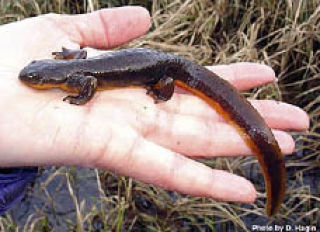Over the past two months, hundreds of rough-skinned newts (Taricha granulosa) tried to cross San Juan County roads on the way from summer breeding ponds to forested winter foraging areas. Far too many were squashed by careless motorists, leaving telltale ribbons of newt-shaped stains on the asphalt.
Only female newts appear to migrate in the islands. The males remain behind in home lakes and ponds and await the females‚Äô return in spring when water levels begin to drop. Female newts signal their return with pheromones‚ “natural perfume,” that arouse males sexually. Females prefer to mate with larger males, and then lay their eggs one at a time over several days, and often mate again. Breeding can occur from late April to July. “These orange-bellied newts are one of the islands,” two most abundant amphibians (the other is the tiny Pacific chorus or tree frog, Pseudacris regilla). They are also one of our most amazing animals. If you approach a newt, it may rear up and display its orange belly‚ warning of toxicity. Or it may play dead, absolutely stiff. When it believes the coast is clear, it will make a sudden dash for safety!
Rough-skinned newts exude a very powerful neurotoxin, tetrodotoxin, from their skin and are best handled with gloves. Female newts also confer this toxin on their eggs. But one predator has evolved the ability to tolerate significant amounts of tetrodotoxin‚ the common garter snake (Thanophis sirtalis), also abundant in the San Juan Islands. In fact, eating newts confers protective toxicity on the snake! There is also evidence that the snakes‚ “taste” each newt they catch and reject exceptionally toxic ones.
Genetic evidence indicates that rough-skinned newts spread north into the Salish Sea from northern California and Oregon after the retreat of the last continental glaciers, less than 10,000 years ago. They probably made their way to the San Juan Islands even more recently, and it is quite possible that our island newts are genetically distinct from mainland newts, and better adapted to our relatively dry, rain shadow‚ climate.
Newts tend to dominate ponds and lakes once they get established. They are not territorial and can live comfortably at very high population densities. Yet they disappear completely if competing fish or amphibians are introduced to their breeding ponds. The greatest threats to San Juan County‚ newts are non-native warm water fish such as carp and bass, introduced over the years by the State and private landowners as game fish, and more recently introduced bullfrogs from the East Coast. Introducing these exotic species is a death sentence for rough-skinned newts, and we are seeing newts in fewer and fewer ponds and lakes.
So please drive carefully! And if you have newts on your property, enjoy their aquatic antics without disturbing them or introducing non-native predators.
You can see newt migrations around Hummel Lake on Lopez and Summit Lake on Orcas. They prefer to take paths through wooded areas. If you have a newt pond, or know of a migration trail across a county road, or if you want to know more about other amphibians on your property, please contact us!
Russel Barsh (RLBarsh@gmail.com) and Madrona Murphy live on Lopez and are conducting biodiversity surveys for the local nonprofit conservation laboratory, Kwiáht. Visit Kwiáht’s new website at www.kwiaht.org.



